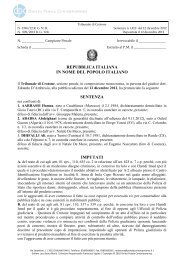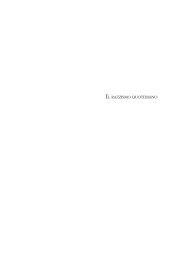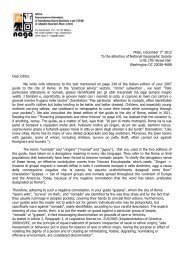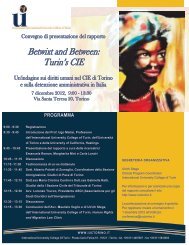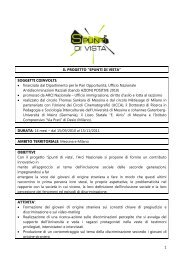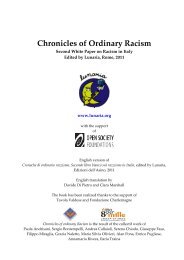Chronicles of ordinary racism 2011 - Cronache di ordinario razzismo
Chronicles of ordinary racism 2011 - Cronache di ordinario razzismo
Chronicles of ordinary racism 2011 - Cronache di ordinario razzismo
- No tags were found...
You also want an ePaper? Increase the reach of your titles
YUMPU automatically turns print PDFs into web optimized ePapers that Google loves.
as a decommissioned oil mill, the former Opera Sila, the former la “Rognetta” plant and<br />
several ruined, isolated farmsteads with no sanitary installations. And there is more.<br />
The gunshots on 7 January are not the first to be fired: attacking immigrants with<br />
stones, sticks or firearms is a popular local “game” dating back to at least 1990, when a<br />
young Maghrebian man, Mohammed El Sadki , was shot in the legs. 253<br />
Exploitation, <strong>di</strong>sgraceful living con<strong>di</strong>tions, trampled civil and human rights and<br />
gunshots: for twenty years this has been the life that immigrants who work in the fields<br />
<strong>of</strong> Rosarno have been lea<strong>di</strong>ng.<br />
The protest held on 7 January 2010 is not the first <strong>of</strong> its kind: on 12 December 2008, after<br />
yet another shooting at the expense <strong>of</strong> two young Ivorians who were seriously injured,<br />
immigrants organized a peaceful protest march, which <strong>di</strong>d not, however, elicit any form<br />
<strong>of</strong> acknowledgement from the state.<br />
On 7 January 2010, in the context <strong>of</strong> a crisis that heavily affected a local agricultural<br />
economy which found itself overwhelmed by the competition posed by Southern<br />
Me<strong>di</strong>terranean countries, <strong>di</strong>sastrous EU policies and the Mafia’s constant speculating,<br />
all the rage and frustration accumulated by the foreign farm hands in the course <strong>of</strong><br />
years <strong>of</strong> exploitation and abuses spilt out into open rebellion. At around 6 PM, four<br />
hundred immigrants organized two road blocks on highway 18 and in another part <strong>of</strong><br />
the town, and then proceeded to march through the centre, destroying cars and shop<br />
windows and upturning rubbish bins. The protest continued the following day, this<br />
time with no material damage involved. The riots came as a surprise to everyone: the<br />
local population, police authorities, the me<strong>di</strong>a and the general public, perhaps precisely<br />
because this was the first time that the protest had progressed into a fully‐fledged riot,<br />
despite the endless history <strong>of</strong> intimidation and violence <strong>di</strong>rected against the immigrant<br />
workers. It is even more surprising in an area where the “’ndrangheta” controls<br />
everything and nobody dares to speak up. The State’s influence simply does not reach<br />
as far as Rosarno: locals know this well and immigrants soon pick up on it. This is the<br />
key to understan<strong>di</strong>ng the reasoning behind the facts that occurred between 7th and 10th<br />
January. The real piece <strong>of</strong> news from those days concerned the pogrom carried out<br />
against African workers by groups <strong>of</strong> Rosarno citizens. “Vigilante patrols” <strong>of</strong> locals<br />
conducted a proper man‐hunt against black people for several days: they managed to<br />
injure several immigrants with iron bars, truncheons, billiard cues, stones and firearms;<br />
the old farmhouses where some <strong>of</strong> them lived were burnt to the ground. 254 A<br />
“delegation” went so far as to occupy the town council (replaced by a state‐appointed<br />
<strong>of</strong>ficial while it is investigated for bowing to mafia pressure since 2008) to publicly<br />
advocate the deportation <strong>of</strong> all the African workers. The sprea<strong>di</strong>ng <strong>of</strong> utterly unfounded<br />
information, such as the news that a pregnant mother had lost her baby as the result <strong>of</strong><br />
a blow suffered during the rioting, only served to escalate the tension.<br />
253 Alessio Magro reconstructs the history <strong>of</strong> the attacks suffered by African and Maghrebian immigrants in Rosarno for Il<br />
Manifesto. Cf the article published on 16 February 2010 Calabria infelix, 20 anni <strong>di</strong> violenze e <strong>di</strong> accoglienza, (Calabria infelix,<br />
20 years <strong>of</strong> violence and reception) also contained in the invaluable “Arance insanguinate. Dossier Rosarno”, (bloodstained<br />
oranges. Rosarno dossier) by Associazione Da Sud, http://www.dasud.it.<br />
254 Later, Human Right Watch documented at least nine assaults that resulted in the injury <strong>of</strong> at least eleven immigrants. Cf.<br />
Human Rights watch, L’intolleranza quoti<strong>di</strong>ana. La violenza xen<strong>of</strong>oba e razzista in Italia (Everyday intolerance. Racist and<br />
Xenophobic violence in Italy), <strong>2011</strong>, pag.28. 21 injured foreigners were sent to Calabrian hospitals during those days accor<strong>di</strong>ng<br />
to the Interior minister.<br />
100




